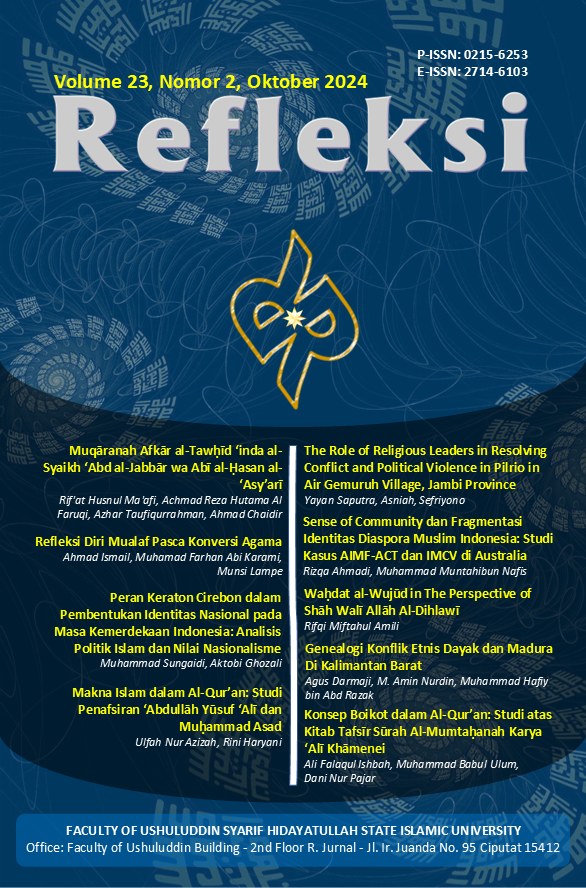Sense of Community dan Fragmentasi Identitas Diaspora Muslim Indonesia: Studi Kasus AIMF-ACT dan IMCV di Australia
DOI:
https://doi.org/10.15408/ref.v23i2.41351Keywords:
Sense of community, Fragmentation, Identity, Social cohesionAbstract
The Indonesian Muslim diaspora maintains both social and Islamic identities in their host countries. In this context, numerous studies indicate that the quest for identity generates divisions among Muslims and might, to some degree, incite disputes and rivalries. This article contradicts that assertion. We collected data during a participatory experience in community service activities grounded in Assets-Based Community Development (ABCD) at two Indonesian Muslim organizations in Australia, specifically AIMF-ACT and IMCV. This article, utilizing the qualitative case study technique, reveals that members of both organizations possess a dynamic sense of community. Amidst the diversity of identities present in each individual, a sense of unity emerges. The sense of community derives from geographical linkages and a collective commitment to the significance of practicing Islam within a diverse context. Although not all members realize it, awareness of the variety of Islamic expressions is rising, which gives rise to a new optimism that variations in how Muslims practice Islam can increase social cohesiveness rather than inevitably cause conflict and hostility. This article categorizes prior theories regarding the sense of community, including the perspectives of David W. McMillan and David M. Chavis.References
A1C. wawancara, November 15, 2019.
Ahlbrandt, Roger S., and James V. Cunningham. A New Public Policy for Neighborhood Preservation. New York: Praeger, 1979.
Australian Bureau of Statistic. “People in Australia Who Were Born in Indonesia,” 2024. https://www.abs.gov.au/census/find-census-data/quickstats/2021/5202_AUS.
Australian Bureau of Statistics. “2021 Census Shows Changes in Australia’s Religious Diversity | Australian Bureau of Statistics,” June 28, 2022. https://www.abs.gov.au/media-centre/media-releases/2021-census-shows-changes-australias-religious-diversity.
———. “Religious Affiliation in Australia,” July 4, 2022. https://www.abs.gov.au/articles/religious-affiliation-australia.
B1C. wawancara, Agustus 2019.
Bachrach, Kenneth M., and Alex J. Zautra. “Coping with a Community Stressor: The Threat of a Hazardous Waste Facility.” Journal of Health and Social Behavior 26, no. 2 (1985): 127–41. https://doi.org/10.2307/2136602.
Braun, Virginia, and Victoria Clarke. “Using Thematic Analysis in Psychology.” Qualitative Research in Psychology 3, no. 2 (January 1, 2006): 77–101. https://doi.org/10.1191/1478088706qp063oa.
C2C. wawancara, September 5, 2022.
Chavis, David M., and Abraham Wandersman. “Sense of Community in the Urban Environment: A Catalyst for Participation and Community Development.” In A Quarter Century of Community Psychology: Readings from the American Journal of Community Psychology, edited by Tracey A. Revenson, Anthony R. D’Augelli, Sabine E. French, Diane L. Hughes, David Livert, Edward Seidman, Marybeth Shinn, and Hirokazu Yoshikawa, 265–92. Boston, MA: Springer US, 2002. https://doi.org/10.1007/978-1-4419-8646-7_14.
D2C. wawancra, Oktober 2022.
Dahlan, Ahmad, and Akhmad Faozan. “The Synergy of Muslim Communities Abroad in Preventing Islamic Radicalism (Evidence from Indonesia Muslim Community in Victoria, Australia).” Ijtimā Iyya Journal of Muslim Society Research 6, no. 1 (March 26, 2021): 89–102. https://doi.org/10.24090/ijtimaiyya.v6i1.7515.
Doolittle, Robert J., and Donald Macdonald. “Communication and a Sense of Community in a Metropolitan Neighborhood: A Factor Analytic Examination.” Communication Quarterly 26, no. 3 (June 1, 1978): 2–7. https://doi.org/10.1080/01463377809369297.
E1C. wawancara, Oktober 2022.
F1V. wawancara, November 8, 2022.
Fakhruroji, Moch. “Maintaining Indonesian Muslim Identity through Islamic Study Groups.” Komunitas 11, no. 1 (March 28, 2019): 75–84.
Florin, Paul R., and Abraham Wandersman. “Cognitive Social Learning and Participation in Community Development.” American Journal of Community Psychology 12, no. 6 (1984): 689–708. https://doi.org/10.1007/BF00922619.
G1V. wawancara, November 20, 2022.
Ganter, Regina. “Histories with Traction: Macassan Contact in the Framework of Muslim Australian History.” In Macassan History and Heritage: Journeys, Encounters and Influences, edited by Marshall Clark and Sally K. May. Canberra: ANU Press, 2013.
Gusfield, Joseph R. Community: A Critical Response. Harper & Row, 1975.
H1V. wawancara, Oktober 2022.
Hassan, Riaz. Australian Muslim: The Chalenge of Islamophobia and Social Distance 2018. Adelaide: International Centre for Muslim and non-Muslim Understanding 2018 University of South Australia, 2018.
I2V. wawancara, November 5, 2022.
IMCV. “Indonesian Muslim Community of Victoria.” Indonesian Muslim Community of Victoria, 2023. https://www.imcv.org.au.
Macknight, Charles Campbell. The Voyage to Marege: Macassan Trepangers in Northern Australia. Melbourne University Press, 1976.
McIntosh, Ian S. “Islam and Australia’s Aborigines? A Perspective from North-East Arnhem Lnnd.” Journal of Religious History 20, no. 1 (1996): 53–77. https://doi.org/10.1111/j.1467-9809.1996.tb00692.x.
McMillan, David. Sense of Community: An Attempt at Definition. George Peabody College for Teachers, 1976.
Mcmillan, David, and David Chavis. “Sense of Community: A Definition and Theory.” Journal of Community Psychology 14 (January 1, 1986): 6–23. https://doi.org/10.1002/1520-6629(198601)14:13.0.CO;2-I.
Nafis, Muhammad Muntahibun, and Rizqa Ahmadi. Islamophobia, Wasathiyah Islam, and Indoensian Muslim Diaspora: Fostering the Islamic Activism in Australia through Peaceful Activities. Yogyakarta: Bildung, 2023.
Onnudottir, Helena, Adam Possamai, and Bryan Turner. “Islam: A New Religious Vehicle for Aboriginal Self-Empowerment in Australia?” International Journal for the Study of New Religions, 2010.
Riger, Stephanie, and Paul J. Lavrakas. “Community Ties: Patterns of Attachment and Social Interaction in Urban Neighborhoods.” American Journal of Community Psychology 9, no. 1 (1981): 55–66. https://doi.org/10.1007/BF00896360.
Riger, Stephanie, Robert K. LeBailly, and Margaret T. Gordon. “Community Ties and Urbanites’ Fear of Crime: An Ecological Investigation.” American Journal of Community Psychology 9, no. 6 (1981): 653–65. https://doi.org/10.1007/BF00896247.
Toyibah, Dzuriyatun, Wiwi Siti Syajaroh, and Ade Rina Farida. “Indonesian muslim millennials in Australia: Islamic organizations and multiculturalism among the diaspora,” December 2018. https://repository.uinjkt.ac.id/dspace/handle/123456789/54657.
Wandersman, Abraham, and Gary A. Giamartino. “Community and Individual Difference Characteristics as Influences on Initial Participation.” American Journal of Community Psychology 8, no. 2 (April 1, 1980): 217–28. https://doi.org/10.1007/BF00912661.
Downloads
Published
Issue
Section
License
Copyright (c) 2024 Rizqa Ahmadi, Muhammad Muntahibun Nafis, Wildani Hefni

This work is licensed under a Creative Commons Attribution 4.0 International License.








